Short Summary
Unit 42 has identified ongoing malicious activities by North Korean threat actors, known as the CL-STA-240 Contagious Interview campaign. These actors pose as recruiters to lure job seekers into downloading malware, specifically the BeaverTail downloader and the InvisibleFerret backdoor. The campaign has evolved with updates to the malware, which now targets both macOS and Windows platforms, and includes features for stealing sensitive data, particularly cryptocurrency wallets.
Key Points
- Campaign Name: CL-STA-240 Contagious Interview
- Threat Actors: Associated with the Democratic People’s Republic of Korea (DPRK)
- Malware Used: BeaverTail downloader and InvisibleFerret backdoor
- Recruitment Method: Fake job interviews on platforms like LinkedIn
- Malware Capabilities:
- Data exfiltration
- Stealing browser passwords
- Targeting cryptocurrency wallets
- Cross-Platform Functionality: New versions of BeaverTail compiled using the Qt framework for both macOS and Windows
- Indicators of Compromise: Specific SHA256 hashes and IP addresses associated with the malware
- Protection Measures: Palo Alto Networks products provide detection and prevention capabilities against these threats
MITRE ATT&CK TTPs – created by AI
- Credential Dumping (T1003)
- Stealing browser passwords and credentials.
- Exploitation for Client Execution (T1203)
- Convincing victims to execute malicious code during online interviews.
- Command and Control (T1071)
- Establishing communication with the attacker’s command and control server.
- Data Encrypted (T1022)
- Exfiltrating sensitive data back to the attackers.
- Remote Access Tools (T1219)
- Using the InvisibleFerret backdoor for remote control of infected endpoints.
Executive Summary
Unit 42 has tracked activity from threat actors associated with the Democratic People’s Republic of Korea (DPRK), where they pose as recruiters to install malware on tech industry job seekers’ devices. We call this activity the CL-STA-240 Contagious Interview campaign, and we first published about it in November 2023. Since that publication, we’ve observed additional online activity from the fake recruiters, as well as code updates to two pieces of malware associated with the campaign; the BeaverTail downloader and the InvisibleFerret backdoor.
The BeaverTail malware associated with this campaign has been compiled using the Qt framework as early as July 2024. We have observed multiple samples of BeaverTail that are compiled for both macOS and Windows platforms. In addition, we observed continuous code updates to the InvisibleFerret backdoor delivered by the BeaverTail downloader.
In this article, we will discuss the online activity of fake recruiters and technical details of the campaign, including the following specifics:
- Analyzing the macOS, Windows and Python malware
- Providing examples of Cortex XDR detecting and preventing this cross-platform threat
Palo Alto Networks customers are better protected from the threats discussed in this article through our Network Security solutions, Prisma Cloud offerings and the Cortex line of products.
If you think you might have been compromised or have an urgent matter, contact the Unit 42 Incident Response team.
Social Engineering and Infection: Fake Recruiters and Job Interviews
As described in our previous article on Contagious Interview, the threat actor behind CL-STA-0240 contacts software developers through job search platforms by posing as a prospective employer. The attackers invite the victim to participate in an online interview, where the threat actor attempts to convince the victim to download and install malware. Recent reporting and social media activity like this thread on X (formerly Twitter) indicate this activity continues.
A June 2024 Medium article describes a relatively recent example. In this case, a fake recruiter account using the name Onder Kayabasi contacted the writer over LinkedIn.
While this LinkedIn account is no longer available, a similar account for Onder Kayabasi remained active on X (formerly known as Twitter) as recently as August 2024. Figure 1 shows the X profile for this user.

After the attacker set up a technical interview online, the attacker convinced the potential victim to execute malicious code. In this case, the potential victim purposefully ran the code in a virtual environment, which eventually connected back to the attacker’s command and control (C2) server 95.164.17[.]24:1224, as noted below in Figure 2.
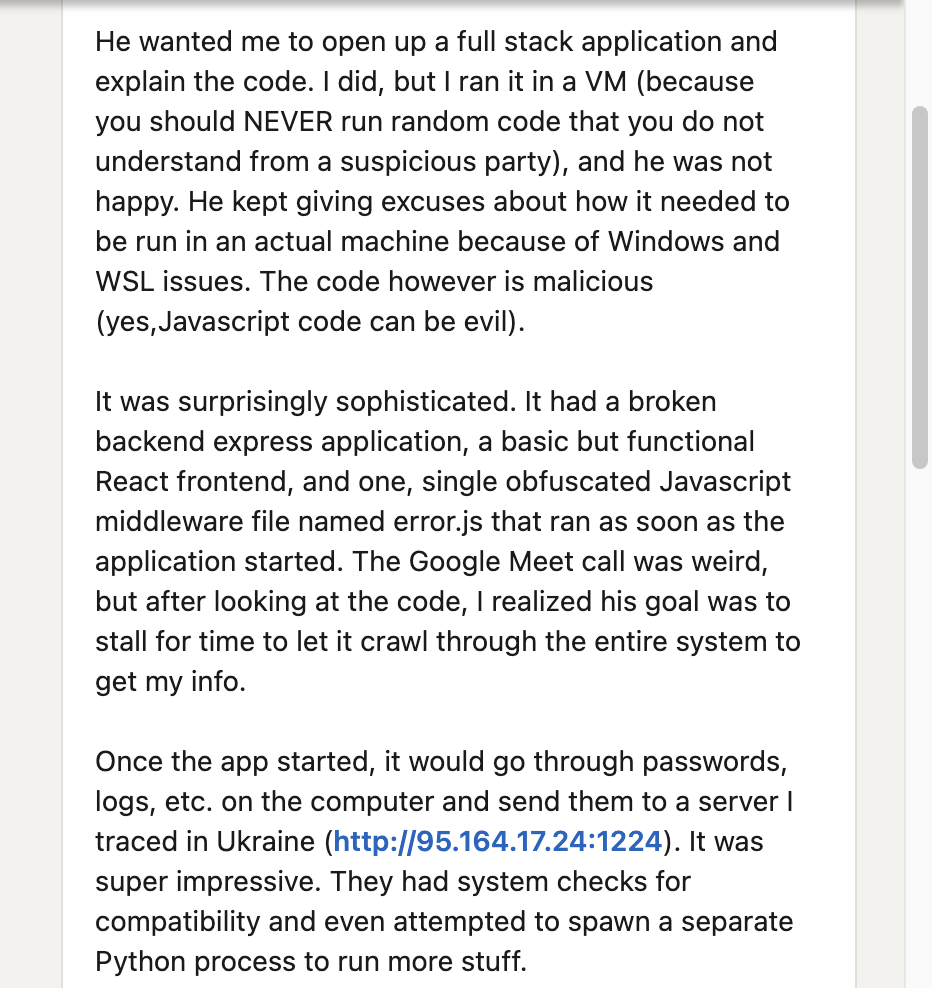
Another social media post noted the same type of activity and IP address on Reddit as noted below in Figure 3. This is the same IP address and TCP port used by the new version of the BeaverTail malware that we analyze in the next section.
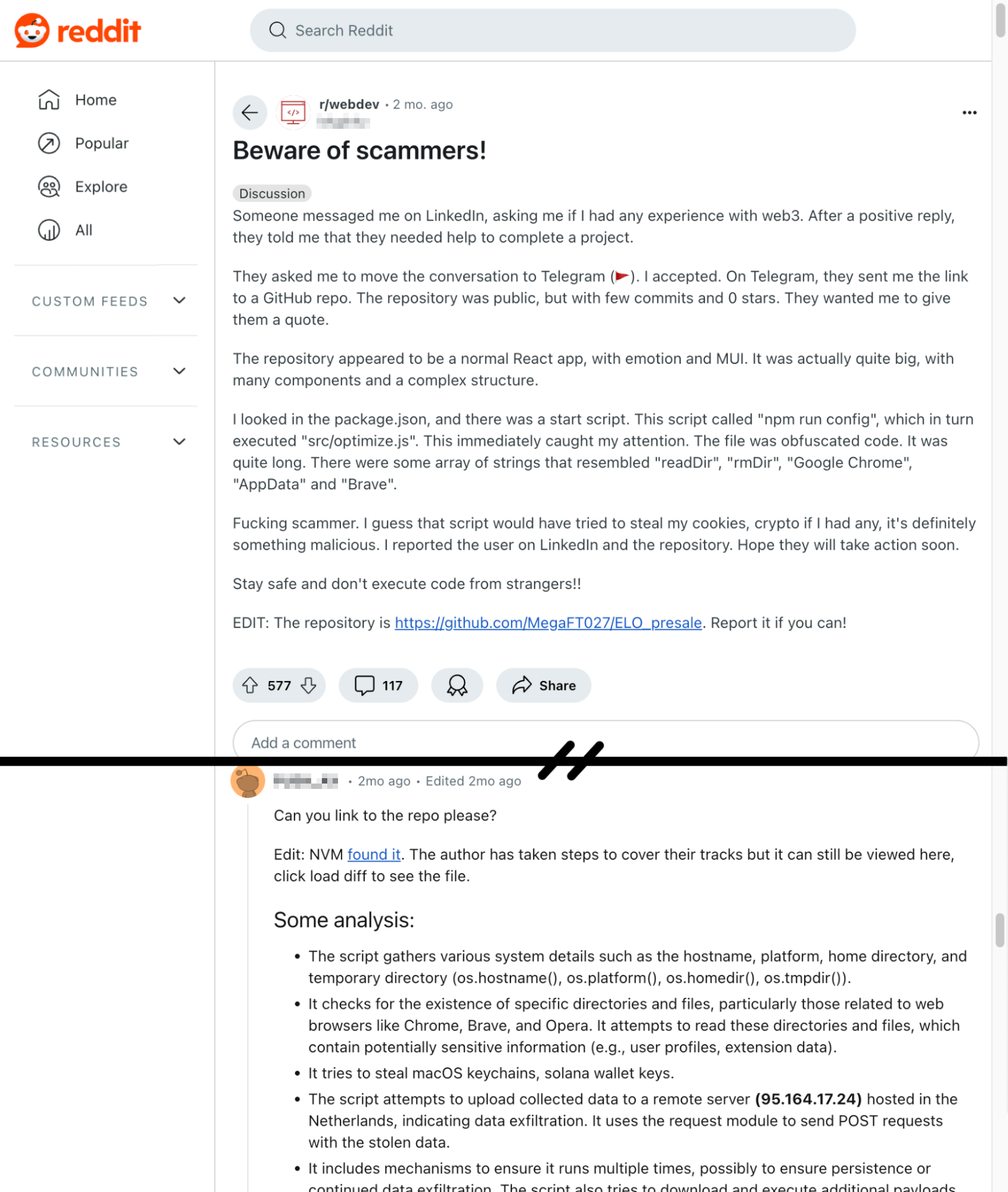
This activity is consistent with our previous report on the CL-STA-0240 Contagious Interview campaign. And like previous activity from this campaign, the initial malware is BeaverTail.
Analysis of BeaverTail’s New Cross-Platform Version
BeaverTail is a downloader and infostealer associated with the CL-STA-0240 campaign, which we first reported on in 2023. In this campaign the attackers delivered BeaverTail via files masquerading as the following applications:
- MiroTalk, a real-time video call application
- FreeConference, a service that offers free conference calling
Threat actors often abuse, take advantage of or subvert legitimate products for malicious purposes. This does not imply that the legitimate product is flawed or malicious.
Similar findings were also detailed in GROUP-IB’s recent research.
In recent months, the attackers created new versions of the BeaverTail malware. This time instead of coding it in JavaScript like previous versions, they wrote the new version in Qt.
Since Qt enables developers to create cross-platform applications, the attackers could use the same source code to compile applications for both Windows and macOS simultaneously. Figure 4 shows the installation process of BeaverTail in both Windows and macOS.

When installing the macOS variant of BeaverTail in the form of a fake MiroTalk package, the victim must mount the MiroTalk.dmg disk image and run the package within that image. For Windows, the respective installation package file is named MiroTalk.msi.
Objective-See published an article in July 2024 analyzing the macOS version of BeaverTail, describing its main capabilities, such as data exfiltration and execution of additional payloads.
After the malicious applications are successfully installed, when the victim opens the applications for the first time, they see a GUI as shown in Figure 5.
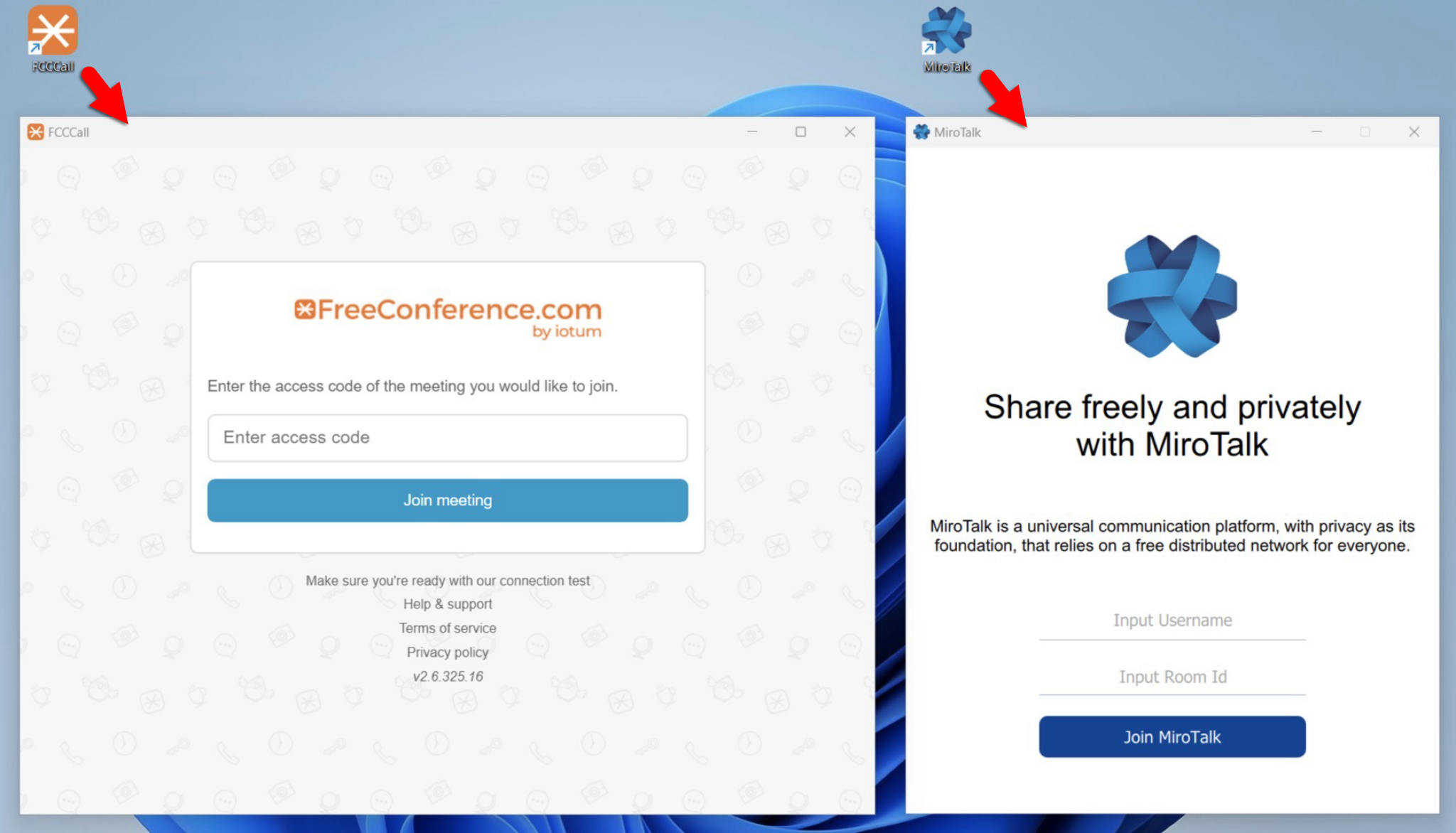
Meanwhile, BeaverTail executes its malicious code in the background, collecting data and exfiltrating it from the victim’s host without any visible indicators.
This Qt-based version of BeaverTail has largely the same functionality as the JavaScript-based version we analyzed in November 2023. Additional features in this new Qt version of BeaverTail include:
- Stealing browser passwords in macOS
- Stealing cryptocurrency wallets in both macOS and Windows (shown in Figure 6)
This last feature is consistent with the ongoing financial interests of North Korean threat actors.

Additionally, this newer Qt version of BeaverTail targets 13 different cryptocurrency wallet browser extensions, compared to only nine wallets previously targeted by the JavaScript variant. Of the current 13 extensions, the authors added 5 for new wallets, and removed one. Table 1 lists the cryptocurrency wallet browser extensions IDs, names and targeted browsers.
| Browser Extension ID | Browser Extension Name | Targeted Browser |
| nkbihfbeogaeaoehlefnkodbefgpgknn | MetaMask Wallet | Chrome |
| ejbalbakoplchlghecdalmeeeajnimhm | MetaMask Wallet | Microsoft Edge |
| fhbohimaelbohpjbbldcngcnapndodjp | BNB Chain Wallet (Binance) | Chrome |
| hnfanknocfeofbddgcijnmhnfnkdnaad | Coinbase Wallet | Chrome |
| ibnejdfjmmkpcnlpebklmnkoeoihofec | TronLink Wallet | Chrome |
| bfnaelmomeimhlpmgjnjophhpkkoljpa | Phantom Wallet | Chrome |
| aeachknmefphepccionboohckonoeemg | Coin98 Wallet | Chrome |
| hifafgmccdpekplomjjkcfgodnhcellj | Crypto[.]com Wallet | Chrome |
| jblndlipeogpafnldhgmapagcccfchpi | Kaikas Wallet | Chrome |
| acmacodkjbdgmoleebolmdjonilkdbch | Rabby Wallet | Chrome |
| dlcobpjiigpikoobohmabehhmhfoodbb | Argent X – Starknet wallet | Chrome |
| aholpfdialjgjfhomihkjbmgjidlcdno | Exodus Web3 Wallet | Chrome |
Table 1. Cryptocurrency wallet extension IDs, names and targeted browsers.
After exfiltrating collected data to the C2, BeaverTail attempts to download the Python programming language to the infected machine from the URL hxxp://<c2_server>:1224/pdown. Downloading Python is essential to successfully executing the InvisibleFerret backdoor payload, which is written in Python. This enables InvisibleFerret to be cross platform as well.
Figure 7 below shows the code responsible for downloading Python from BeaverTail’s C2 server.

Next, the malware will download the first stage of InvisibleFerret from the URL hxxp://<c2_server>:1224/client/<campaign_id>, as shown in Figure 8.

The Final Python Backdoor Payload: InvisibleFerret
InvisibleFerret is a Python backdoor that we fully analyzed in our previous article on the Contagious Interview campaign. InvisibleFerret has multiple components:
- An initial downloader: Responsible for downloading the other two components listed below
- Main payload component – Its capabilities include:
- Fingerprinting the infected endpoint
- Remote control of the infected endpoint
- Keylogging
- Exfiltrating sensitive files
- Downloading the AnyDesk client on-demand for additional remote control capabilities
- Browser stealer component: Enables the attackers to steal browser credentials and credit card information
Figure 9 shows the execution flow of InvisibleFerret’s components as described in our previous analysis.
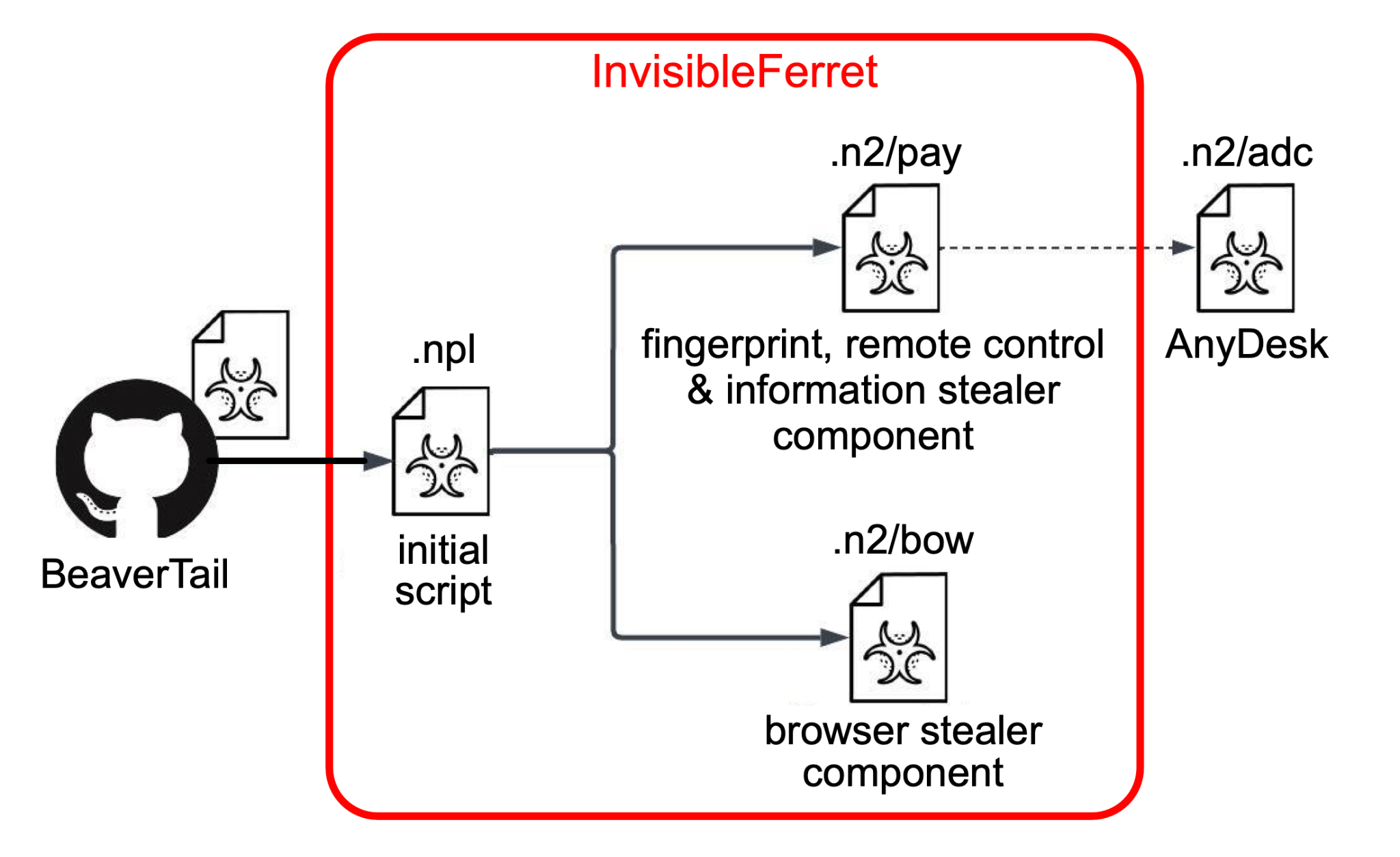
By examining the latest InvisibleFerret versions deployed in this campaign during the past year, we saw slight code changes implemented over time. While its general functionality remains nearly identical, these changes suggest that the malware authors are actively working on the malware’s code in between the waves of their attacks.
In this section we will examine the code changes between the InvisibleFerret backdoor deployed by the BeaverTail installer that masquerades as MiroTalk and the BeaverTail installer that masquerades as the FreeConference service application. Noticeable code modifications are shown in Table 2.
| Command | InvisibleFerret Installed by Fake MiroTalk Installer | InvisibleFerret Installed by Fake FreeConference Installer |
| ssh_cmd | Checks if the argument value is equal to delete and if so, closes the session. To notify the C2 server, it sends the message string [close]. | Checks the OS type. If the OS type is Windows, it tries to kill python.exe via the taskkill command. If the OS type is not Windows, it tries to kill Python via the killall command |
| ssh_env | Collects content from specific folders (Documents and Downloads for Windows, /home and /Volumes for others), and uploads these files to the attacker’s FTP server. | On Windows: Collects .env files from all folders under the following drives: C:, D:, E, F:, G: while ignoring folders named node_modules. Other OSes: Collects .env files from all folders under the home directory (~) while ignoring folders named node_modules |
Table 2. InvisibleFerret code updates.
Figure 10 shows a comparison of the ssh_cmd function code between the different versions of InvisibleFerret.

Another interesting change was implemented in one of the subcommands of ssh_upload named ss_ufind. This subcommand enables the attackers to search for files matching a given pattern.
In the older InvisibleFerret version, the attackers first collected the names of all the files and only then did the Python code filter out names by pattern. In the newer version, InvisibleFerret uses the Windows findstr or macOS find commands to search for the files by a specific pattern, thus making the code more efficient.
Conclusion
In this article, we present recent activity from the CL-STA-0240 Contagious Interview campaign.
In this campaign, the attackers targeted job-seeking individuals on LinkedIn, luring them to download and execute malware that masquerades as a legitimate video call application. This campaign is a continuation of activity we initially reported in November 2023.
The attackers behind this campaign introduced a new Qt version of the BeaverTail malware as early as July 2024. The malware authors compiled BeaverTail variants for both Windows and macOS from the same source code using the Qt programming language.
North Korean threat actors are known to conduct financial crimes for funds to support the DPRK regime. This campaign may be financially motivated, since the BeaverTail malware has the capability of stealing 13 different cryptocurrency wallets.
The infection chain culminates in deploying the InvisibleFerret Python backdoor, which enabled the attackers to maintain control of the machine and exfiltrate sensitive data. We also detailed new features of the InvisibleFerret Python backdoor variant seen in this campaign.
Another important risk that this campaign poses is potential infiltration of the companies who employ the targeted job seekers. A successful infection on a company-owned endpoint could result in collection and exfiltration of sensitive information.
It is essential for individuals and organizations to be aware of such advanced social engineering campaigns. We encourage the community to leverage our findings to inform the deployment of protective measures to defend against such threats.
Protections and Mitigations
BeaverTail and InvisibleFerret are detected and prevented in Cortex XDR both on macOS and Windows platforms. Figure 11 shows the execution, detection and prevention of the BeaverTail Windows variant and InvisibleFerret as seen in Cortex XDR.
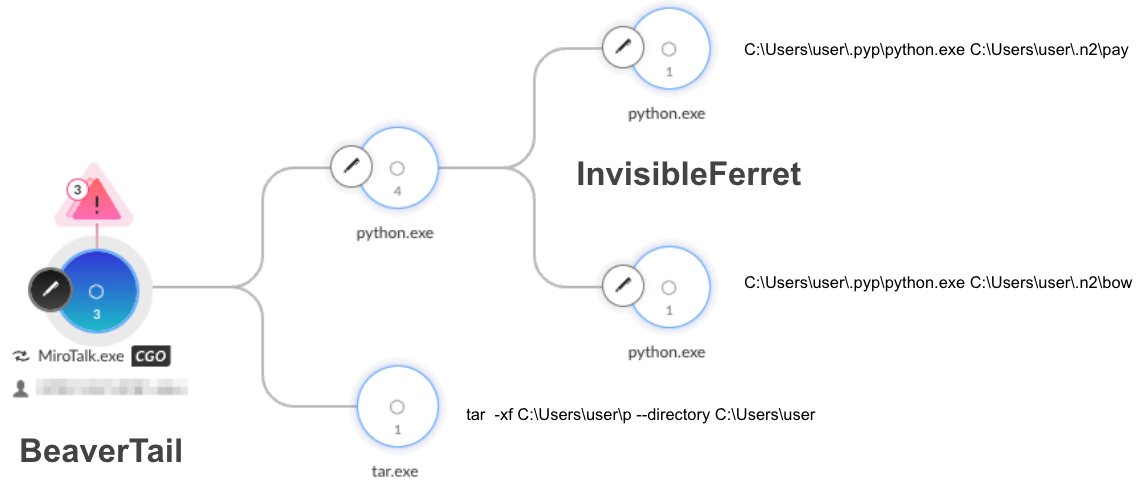
Figure 12 shows the execution, detection and prevention of the BeaverTail macOS version and InvisibleFerret as seen in Cortex XDR.

For Palo Alto Networks customers, our products and services provide the following coverage associated with this group:
- The Advanced WildFire machine-learning models and analysis techniques have been reviewed and updated in light of the IoCs shared in this research.
- Advanced URL Filtering and Advanced DNS Security identify known URLs and domains associated with this activity as malicious.
- The Next-Generation Firewall with the Advanced Threat Prevention security subscription can help block the attacks with best practices via the following Threat Prevention signatures: 86817, 86818 and 86819.
- Cortex XDR and XSIAM are designed to:
- Prevent the execution of known malicious malware and prevent the execution of unknown malware using Behavioral Threat Protection as well as machine learning based on the Local Analysis module
- Protect against credential gathering tools and techniques using the new Credential Gathering Protection available from Cortex XDR
- Protect from threat actors dropping and executing commands from web shells using Anti-Webshell Protection, newly released in Cortex XDR
- Protect against exploitation of different vulnerabilities including ProxyShell and ProxyLogon using the Anti-Exploitation modules as well as Behavioral Threat Protection, including credential-based attacks, with behavioral analytics, through Cortex XDR Pro
- Prisma Cloud Compute and Advanced WildFire integration can help detect and prevent malicious execution of the malware within Windows-based VM, container and serverless cloud infrastructure
If you think you might have been impacted or have an urgent matter, get in touch with the Unit 42 Incident Response team or call:
- North America Toll-Free: 866.486.4842 (866.4.UNIT42)
- EMEA: +31.20.299.3130
- APAC: +65.6983.8730
- Japan: +81.50.1790.0200
Indicators of Compromise
BeaverTail Installer – macOS DMG disk image:
- 000b4a77b1905cabdb59d2b576f6da1b2ef55a0258004e4a9e290e9f41fb6923
- 9abf6b93eafb797a3556bea1fe8a3b7311d2864d5a9a3687fce84bc1ec4a428c
SHA256 hash for BeaverTail – macOS Mach-O executable file:
- 0f5f0a3ac843df675168f82021c24180ea22f764f87f82f9f77fe8f0ba0b7132
- d801ad1beeab3500c65434da51326d7648a3c54923d794b2411b7b6a2960f31e
SHA256 hashes for BeaverTail Installers – Windows MSI files:
- 36cac29ff3c503c2123514ea903836d5ad81067508a8e16f7947e3e675a08670
- de6f9e9e2ce58a604fe22a9d42144191cfc90b4e0048dffcc69d696826ff7170
- fd9e8fcc5bda88870b12b47cbb1cc8775ccff285f980c4a2b683463b26e36bf0
SHA256 hashes for BeaverTail – Windows EXE files:
- 0621d37818c35e2557fdd8a729e50ea662ba518df8ca61a44cc3add5c6deb3cd
- 9e3a9dbf10793a27361b3cef4d2c87dbd3662646f4470e5242074df4cb96c6b4
- d5c0b89e1dfbe9f5e5b2c3f745af895a36adf772f0b72a22052ae6dfa045cea6
IP addresses for BeaverTail & InvisibleFerret C2 servers:
- 95.164.17[.]24
- 185.235.241[.]208
SHA256 hashes for InvisibleFerret related components:
- 07183a60ebcb02546c53e82d92da3ddcf447d7a1438496c4437ec06b4d9eb287
- 10f86be3e564f2e463e45420eb5f9fbdb14f7427eac665cd9cc7901efbc4cc59
- 1c218d15b35b79d762b966db8bc2ca90fc62a95903bd78ac85648de1d828dbce
- 34170bda5eb84d737577096438a776a968cb36eff88817f12317edcb9d144b35
- 4343fa4e313a61f10de08fa5b1b8acb98589faf5739ab5b606f540983b630f79
- 486a9a79bbb81abee2e81679ace6267c3f3e37d9b8c8074f9ec7aebc9be75cdd
- 589e22005aa166b207a7aa7384dd3c7f90b71775688e587108801c3894a43358
- 5e820d8b2bd139b3018574c349cd48ce77e7b31cf85e9462712167fcab99b30a
- 6e065f1e4d1d8232da5de830d270a13fff8284a91e81c060377ebe66aa75d81d
- 8563eecbc85a0c43b689b9d9f31fe5977e630c276dee0d7dbfe1a47ab1ab4550
- 8de446957ce96826628c88da9fd4e7ff9d6327d8004afc4e9e86d59e7d6948dc
- 9ece783ac52c9ec2f6bdfa669763a7ed1bbb24af1e04e029a0a91954582690cf
- a69e89a62203b8f2f89ec12a13e46c71b6b4d505deb19527ff73fd002df9bc6b
- ad8a819d7b68905fa6a8425295755c329504dd0bb48b2fba8dd17e54562b0c6f
- b9be6b0ac414ac2a033c17c3ac649417e97e5d0580db796a8ff55169299de50e
- cde5afd20b7bb5c9457b68e02c13094125025fb974df425020361303dc6fcdfc
- d0a5b9dc988834cc930624661e6e7dd1943d480d75594fff0f4bc39d229c5999
- e0568196f1494137a5bbee897a37bc4fe15f87175b57a30403450a88486190c4
- f08e88c7397443e35697e145887af2683a83d2415ccd0c7536cea09e35da9ef7
Source: Original Post